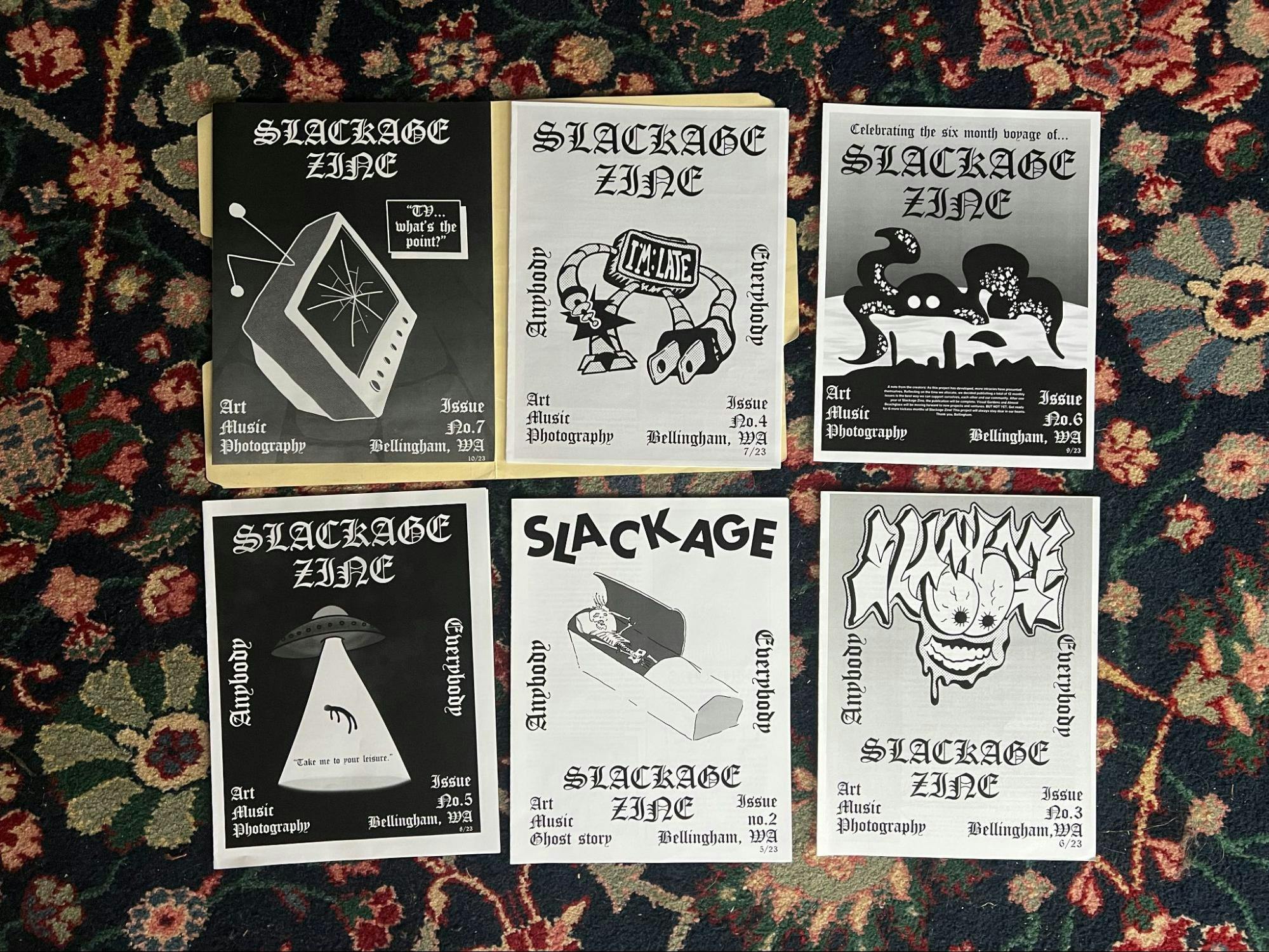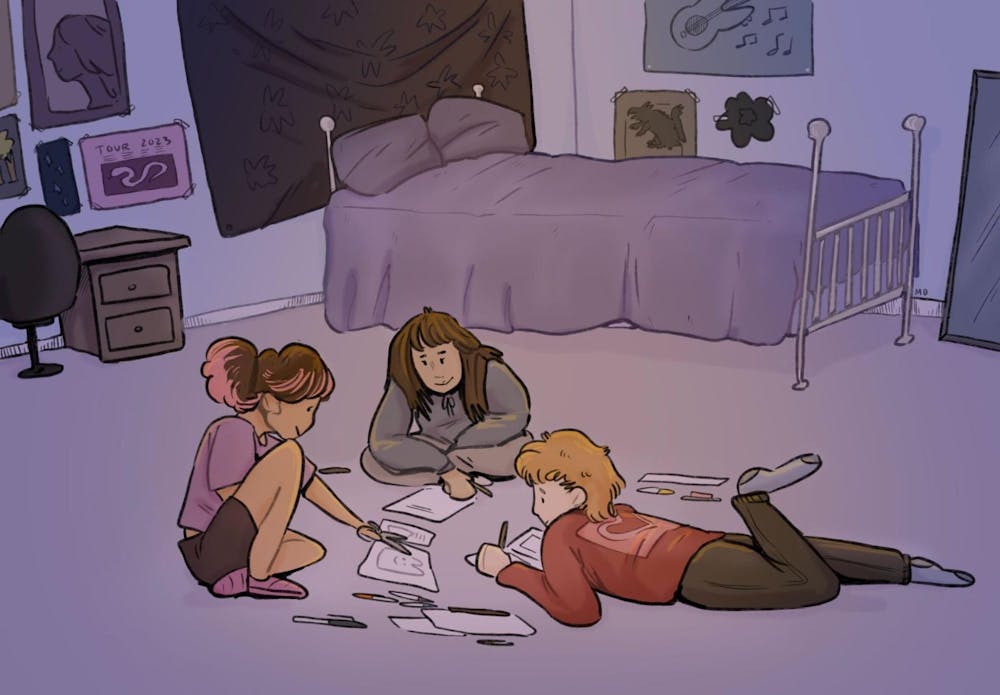Students familiar with the nooks and crannies of Western Washington University’s campus might have encountered an assortment of paper booklets called zines.
These short-form, non-commercial fan magazines began with "The Comet" in 1930, an indie publication focused on the discussion of science and science fiction. However, the art form didn’t take off until it became a staple of punk communication in the ‘70s.
“Every scene, every indie music scene, every punk-rock scene obviously needs people to play music, but just as importantly, it needs people to pick up a camera and take pictures, learn how to use recording equipment and help them make records, they need artists to make flyers. It’s very rare that the bands are doing all of this themselves,” said music journalist Jim Ruland.
Ruland became inundated in the world of zines in the ‘90s, writing CD reviews for punk-rock magazine "Flipside" in Los Angeles. He had lived in LA before but moved away for grad school.
“In 1977 when 'Flipside' put out their first issue, it was a bunch of people in a room all speaking their thoughts while listening to the new Cheap Tricks album. 'Slash,' however, was started up by people who were photographers and extremely influential,” Ruland said.

The Fairhaven Zine Library, located on the third floor of the Fairhaven Building on Western Washington University’s Campus on Nov. 17, 2023. Students are free to pick up and drop off zines and other related materials at the bookshelf. // Photo by Seddie LeBlanc
"Slash" magazine was an infamous publication in the punk scene of Southern California. When legendary English punk rock group The Damned toured in the U.S., photographer Melanie Nissen took a photo of lead singer Dave Vanian. The image became the cover of the first issue of "Slash."
“It was kind of a symbiotic thing,” said Keith “KK” Barrett, the drummer for punk band The Screamers. “The magazine supported us and we also supported them. We gave them something to write about and they gave us a platform to get exposed.”
The Screamers were interviewed and appeared in a photo spread for the first issue of “Slash,” Barrett said. They also played at their opening release party.
“They were like an Instagram at the time,” said Barrett. “They were like, ‘Here’s what I’m doing, here’s what I’ve seen, and I’m gonna share it with you.’ Pretty much like photobooth pictures on Instagram at that time. That’s the way you documented yourself.”
While punk-rock zines are among the most popular and long-lasting, zines don’t have to be about music.
“I see a lot of sketchbook zines,” said Western first-year Zoe Kelton. “My favorite are poetry zines. I have a hoarding problem with them. They are so small, it’s easy. There’s a lot of great political zines. It’s a great way to get informed about new issues you weren’t aware of.”
Kelton ran monthly zine-making workshops at the makerspace in their hometown. They have also submitted to zine competitions and recommend attending Short Run, a zine and comic festival in Seattle.
Kelton said making zines with other people has helped them get out of their shell and build community with others who share their interests.
“Being able to make little art about whatever you want, and having that in a shareable format is fantastic,” said Kelton. “It’s really easy to teach other people and then afterwards you have something you can gift to each other. I think it’s a great creative outlet because you feel really accomplished after you do it. You have a little thing!”
Western’s Jeopardy Magazine hosted a Zine Making Night event on Monday, Dec. 11 from 4 to 6 p.m. in Viking Union 567. Jeopardy Magazine will be creating a shared zine library for the Western community, according to a flier posted outside of classrooms in the Communications Facility.
Gilbert Nagle and his friend Connor Roberts created the local zine "Slackage" earlier this year. They were graphic designers who wanted a place to put their work and other people’s work without the constraints of commission work.
Nagle, who publishes under the moniker Almost Beachglass, is interested in all things creative. He interviews tattoo artists, musicians, photographers, hackers and anyone else who piques his interest. Rotating text across the top of the zine’s accompanying website reads “'Slackage' zine is for those who create and for those who haven’t yet.”

The covers of six issues of the Bellingham-based zine “Slackage” on Nov. 22, 2023. Co-founder Gilbert Nagle said the name, which comes from the term “slacker,” encourages them to not take themselves too seriously. // Photo by Seddie LeBlanc
“What I really dig is seeing the nitty-gritty parts of creating that aren’t usually glamorized. When someone finds their art practice or is consistent in it, I feel like they’re glorified to a point where you don’t see the very human steps and disciplines that they got from embodying that stuff. And I think that’s super important for people to see,” Nagle said.
His interviews from the zine are published in podcast form on Spotify. The zines are stocked at local cafes and shops, such as Cheba Hut, Avellino Coffeehouse, Third Planet and more.
While zines can be easier to make with modern digital-editing tech and photocopiers, production costs can be prohibitive. Print advertising used to be able to help cover costs, but has become less and less enticing for advertisers as digital advertising revenue increases.
“It’s interesting that like, all the punk-rock zines’ model was that you get some advertisers, you find some local record stores and some record labels and if you're a local zine some restaurants and bookstores. But nobody advertises in print anymore, so that’s very challenging, and I know it remains challenging for 'Razorcake,' the zine that I write for,” said Ruland.
"Razorcake" is the oldest punk-rock zine that’s still in print, Ruland said. He’s been writing for the publication for over 20 years, since "Flipside" went under in the early 2000s.
The publication is non-profit and distributed internationally. Around 6,000 copies are circulated every two months, Ruland said.
Despite the challenges, zines continue to be produced, both by legacy publications and individuals.
“I think the attraction of it – both the fact that that kind of music is still played and those kinds of creative outputs are still in existence – is that it’s a ground floor. Anybody can do it. There’s no right or wrong. So it’s very attractive for creative people to get involved in it or experiment with it, and to share it,” Barrett said.
Seddie LeBlanc (they/she) is the opinions editor for The Front this quarter. They have previously reported and edited for the Campus News beat. Seddie is in their third year at Western studying journalism and minoring in Law, Diversity, and Justice. In her free time, Seddie enjoys being outside, cooking and going to house shows. You can reach them at Westernfront.opeditor@gmail.com.






